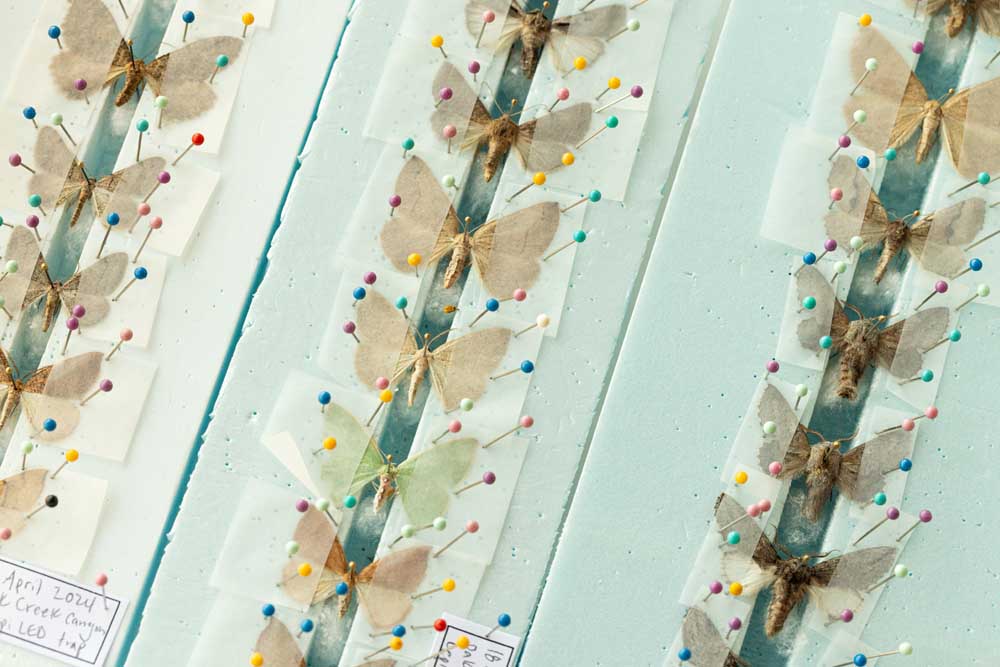Why you just might fall in love with moths
Published 9:34 am Tuesday, October 29, 2024

- YUCCA VALLEY, CA, UNITED STATES - APRIL 27: Moth specimens collected by Laura Gaudette in Oak Creek Canyon in Coconino National Forest in Arizona, photographed in Yucca Valley, California, United States on April 27, 2024. (Photo by Stella Kalinina for The Washington Post)
As humans drop off to sleep, the invisible world of moths comes to life.
Across the planet, billions of the insects take flight on their nocturnal errands.
Few places host more species than California’s Mojave Desert, a center of biodiversity for lepidoptera, the insect family encompassing roughly 180,000 known moth and butterfly species.
Each night in the desert, vast clouds of sphinx moths, some spanning the palm of your hand, speed between night-blooming flowers, sipping nectar. Ethmia, tiny black moths with spots shaped like musical notes, emerge from the dark like fairies. Thousands of geometrid moths, no bigger than your fingernail, slip by cloaked in desert hues from rusty reds to pale green.
To witness them, I traveled deep into the Mojave Desert this spring with a team from the California Academy of Sciences working to ensure the survival of lepidoptera. For two days, we beat bushes, placed traps and collected thousands of moths to see what lives there – and what can be saved.
Moths have inhabited our planet for at least 200 million years. But the conservation status of about 99 percent of moth species remains unknown.
Some, like sphinx moths, remain abundant. Many others are probably being pushed to the brink by development, land-use changes, pesticides and pollution, and rising temperatures. “It’s not this unseen force,” says David Wagner, an entomologist at the University of Connecticut. “It’s humans.”
Over two nights in the desert, I discovered just how easy it is to fall in love with an unloved insect. And why “mothing” may be the best way to discover the miracle of biodiversity in your own backyard.
– – –
Hidden in daylight
On the arid western edge of the Mojave, where the desert floor rises to meet the San Bernardino Mountains, sits the 306-acre Burns Piñon Ridge Reserve.
We venture out in the morning with beating sticks. Hitting the branches of small oaks and rabbitbrush deposits a treasure trove of insect life into collectors made out of fabric: Crane flies, green lacewings, spiders, walking sticks and caterpillars that will one day grow into moths. Wagner and Chris Grinter, an entomologist and collection manager at the California Academy of Sciences, will catalogue the most interesting ones.
The academy houses a collection of 18 million insects, 700,000 of which are butterflies and moth specimens. Many are still waiting for scientists to identify and name them.
Grinter came to the Mojave with scientists and volunteers to bar code as many as possible. The California Insect Barcode Initiative is surveying the state to collect insects and then sequence a tiny, distinctive band of their DNA. Ultimately, these will be added to a database, one chapter in the unwritten book of biodiversity in the Golden State.
Moths are not drab, nocturnal butterflies, says ecologist Katty Baird, author of “Meetings with Moths.” They’re remarkable creatures in their own right.
While some of them feed on crops or clothes, the vast majority sip nectar or eat plants. Bees are busy, but nocturnal moths may pollinate even more plant species, one study found.
Without them, the fabric of life would begin to unravel.
The plight of moths and caterpillars has fascinated Wagner since childhood. After 20 years, he is no less enthusiastic – or worried. Wagner traveled to Burns Piñon to help finish his magnum opus, the successor to his 500-page guide to eastern North America’s caterpillars. The guide for the west will probably run more than 1,500 pages, a testament to the region’s remarkable biodiversity.
As the sun sets, the mood is anticipatory. We head out into the desert to set our traps and see what moths we’ll discover. “The nice thing,” says Grinter, “is moths will come to you.”
– – –
Filling in the blanks
To catch a moth, turn on the light. Any light will do. But we’re using special LED and mercury vapor bulbs that emit ultraviolet, a short-wavelength light – irresistible to moths from several meters away. A bright light induces insects to tilt toward it, like a plane dipping its wings, steering its flight into concentric loops around the source.
We expect to collect thousands of moths over a few days. Most will land on the illuminated sheets, flying away before dawn. The researchers will kill those in the bucket traps and turn the most important into specimens. A few may even be undescribed by science. All we have to do is wait.
Moths are champion fliers. While some never venture far beyond their birthplace, others migrate across countries, rough seas or continents. The death’s-head hawk moth of “The Silence of the Lambs” fame may hold the distance record flying more than 2,000 miles from Europe to Africa each year.
Here in the Mojave Desert, moth migrations happen at night as insects forage for nectar and water, sometimes across many miles. “If you stay put in the desert, you’re going to die,” says Grinter. “You’ll dry out. Pockets of this desert haven’t seen rain in 100 years.”
I keep checking the sheet as midnight nears: Hundreds, perhaps thousands, of moths alight on the white fabric. While a few fly in looping arcs, most lie still or silently vibrate their wings.
As I reach out, the smallest ones shuffle aside, yet a large sphinx moth accepts a gentle touch – it feels almost like stroking a kitten. Then it crawls onto my outstretched hand and perches on my finger.
Moths may be the perfect insect to study, no matter where you live. Hundreds of species reside in a typical neighborhood. With most species yet to be identified, several are probably new to science.
Ask Dave Wikle. The former stock trader started collecting insects as a child. Today, he chases moths across the country to “fill in the blanks” of the lepidoptera family tree. He’s collected hundreds of thousands of moths over his lifetime, at least a dozen species undescribed by scientists.
Does he ever get bored? “Never,” he says. “Because I’m finding new stuff all the time.”
We were lucky.
Over our time in Burns Piñon, Grinter estimates we collected about 500 species. At least four of them appear to be undescribed by entomologists, possibly collected somewhere but never identified and assigned a name.
One was a leaf miner from one of the scrubby oaks in the desert. We watched the tiny caterpillar tunneling through the plant’s leaf. Identifying it was impossible until it emerged as a moth. Nearly a month later, in Grinter’s lab, it did.
The unnamed species in the Gracillariidae family, now a specimen in the academy’s collection, was spectacular: Its fuzzy scales resemble rich brown plumage, long black and white checkered antennas nearly stretch the length of its body and its eyes are hidden under long white scales, like an Afghan hound.
– – –
The new birding
“Mothing is the new birding,” says Liti Haramaty, a researcher at Rutgers University and co-founder of National Moth Week. The hobby attracts more moth fans every year. Each July, citizen scientists collect thousands of observations as part of National Moth Week.
But you can start anytime. Moths are everywhere.
– – –
How to go mothing
Step 1: Set up your moth-attracting station.
All you need is a light and a surface, which can be a sheet or a wall. To capture them, you can also use a bucket and funnel (here’s a simple DIY design and a kid-friendly version) or paint fermented sugar on a tree or twine (here’s a recipe).
Step 2: Sit back and wait.
Moths may show up throughout the day, but prime mothing time is about an hour after sunset through dawn, says Haramaty. Anywhere will work: One entomologist in Scotland recorded 190 species from his tiny balcony facing a parking lot.
Step 3: Identify them.
It’s easy to identify an insect as a moth – unlike butterflies, their wings usually lie flat and they have fuzzy antennas – but it’s hard to tell species apart. A guidebook like the Peterson Field Guide or a silhouette chart can narrow the options.
Perhaps the easiest way is to snap a photo, upload it to iNaturalist and let an algorithm help identify it. You can check iNaturalist’s 14.8 million moth observations to see what’s living near you.
Moths have a shabby reputation in the United States. “There’s been a whole culture of making people afraid of insects,” says Wagner. Many states don’t even legally consider moths, or any insects, to be wildlife.
But insects are beloved elsewhere. In Japan, crickets sing in people’s homes, butterfly nets are sold at department stores and beetles are coveted pets.
Does collecting hurt conservation? No, says Grinter. Populations are generally too abundant to be affected by ethical small-scale collecting: Take only what you need, share observations, respect property rights and protect habitat. Collecting is how most people begin to understand and love insects.
Grinter says insects will always be with us, but the most vulnerable are threatened by death from a thousand cuts. “It really comes down to habitat,” says Grinter. Everyone can help by planting more native host plants, avoiding pesticides and turning off outside lights (bright lights attract and exhaust insects, leaving them vulnerable to predation).
“The paradox is that insects will always and forever be superabundant,” he says. “The diversity is in decline. … For all the ones that are winning, there are a lot that are losing.”








